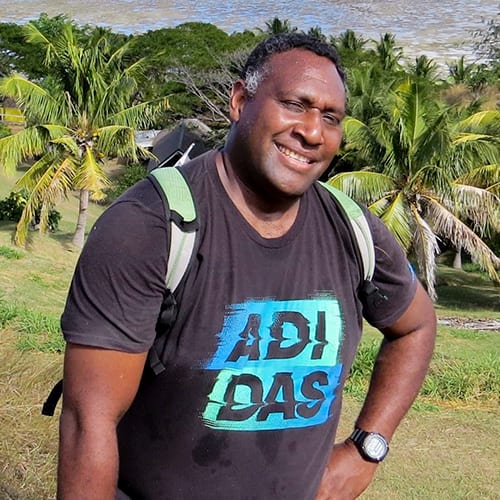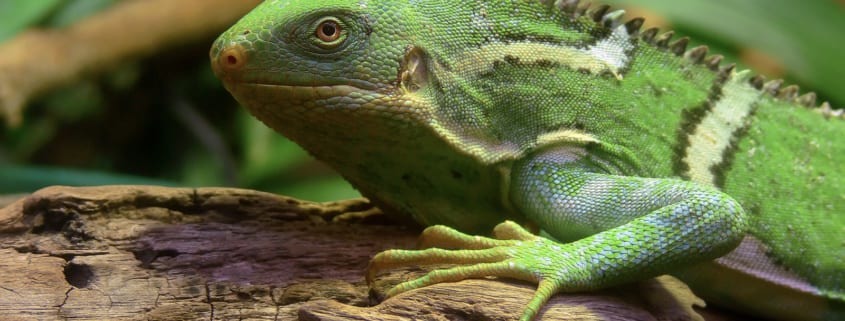Voices from the Rainforest: Jone Niukula, Rainforest Trust Fellow
Rainforest Trust projects thrive thanks to the important conservation work of people on the ground. Our Voices from the Rainforest series brings you news from our projects in Latin America, Africa, Asia and the Pacific — from the perspectives of those working in and for the rainforests.

Inspiring Iguana Conservation in Fiji

Jone Niukula. Photo by National Trust of Fiji.
Jone Niukula has experience managing the Sigatoka Sand Dunes National Park and Yadua Taba Wildlife Sanctuary, both natural heritage sites in Fiji. He has contributed to endangered species conservation programs for the Critically Endangered Fiji Petrel and endemic iguanas. Since 2002, Jone has worked for the National Trust of Fiji.
Why did you become a conservationist?
After studying Geography and Geology at the University of the South Pacific, I was quite excited about finding work in the environmental field. I lived close to the National Trust Director’s home at that time, and she invited me to apply for a job at the Trust. When I applied, I learned that the Trust’s main purpose was not only to protect nature, but our cultural heritage as well.
Tell us about a time that you felt you had made a difference as a conservationist.
I like to believe that my strength lies in communicating and working with the traditional landowners and the native community. My work includes overlooking the iguana conservation program in Fiji and achieving positive relationships with the community that helps run the programs through their support and involvement.
What has surprised you the most in the field?
The existence of different kinds of species in a relatively small country like Fiji. In addition, the species are endemic or at least a sub-species or race special to an area and found nowhere else in the world.
What inspires you most or makes you proud about being a Fellow?
I believe I’m one of the few, if not the only, Fellow from a Pacific Island country this year. So my participation in this program shows the significance of our fauna and flora in the Pacific and the conservation work that is currently being carried out.
I’m also happy to participate because I have the opportunity to be a part of the protection of a unique iguana species that occurs only in the Pacific that’s also a delicacy for the traditional landowners. Tell us about a conservation challenge in your job.
Tell us about a conservation challenge.
A major conservation challenge in Fiji is convincing landowners to surrender their land or resources to save a species. Fijians have come to realize in the past few decades the value of natural resources and that they can receive money if they surrender land or resources. Fortunately, for a few programs, some species of concern have cultural value that will certainly support the need to save them.
Tell us about a conservation success.
Monuriki Island was identified in the Iguana Specialist Group meeting in 2004 as a priority site for conservation of the Fijian Crested Iguana (Brachylophus vitiensis). However, before 2004 and until 2009, there have been numerous requests made to the landowners to remove goats that were introduced to the island in the 1970s and were a major cause of degradation on the island.
In 2010, a team from the National Trust visited the landowners to request for the removal of iguanas for a captive breeding program. This was well received by a newly installed chief who also stated that he would order the removal of that goats, which surprised and excited the visiting conservation team.
And in 2015, the first 32 captive-bred Crested Iguanas were released back on Monuriki Island. In 2017, the captive breeding program was brought to an end when 16 of the original 20 iguana founders, and an additional 32 captive bred offspring, were released. Only a few young iguanas remain in captivity at the moment and are set for release in June.
Between February and June 2017, 35 wild iguanas (not passing through captivity) were caught and marked. Many of these were young animals that would have hatched after the goat and rat eradication was completed in late 2011. This sample of iguanas revealed that, within five years, the small remaining population of iguanas is reproducing and recruiting back into the recovering habitat.
Why is conservation important?
This question can have different answers depending on which stakeholder you are in the program. But the most important answer is to save species and ecosystems from being lost forever from this world.
Header image: The Fijian Crested Iguana. Photo by Benjamin T.





